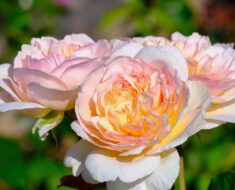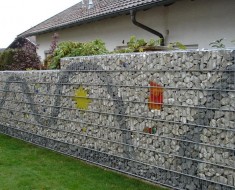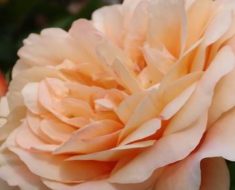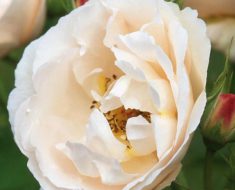English rose PERTIDA is one of D. Austin’s roses. This beautiful and densely terry bastard belongs to spray roses or scrubs. The flowers are painted in delicate shades of apricot pink tones. She is still popular among rose growers. The rose PERTIDA is named after one of the Shakespearean heroines.
CHARACTERISTICS OF PERDITA ROSES
- Group – English roses (English Roses)
- Main form – bush (shrub)
- Height – up to 1.2 m
- Diameter – up to 1 m
- Bush form – round
- Flower color – light apricot pink shades, creamy (milky)
- Number of petals – 26-40
- Flower shape – cup-shaped rosette
- Flower size – 8-10 cm
- Flowering shape – brush
- Flowering type – repeating
- Aroma – rich, strong, spicy
- Foliage – green, dense, with shine, large
- Shoots – straight, with many spikes, strong
- Features – PERTIDA rose grows well in sunny areas; thermophilic; for landing suitable southern, eastern and western directions; in warm regions, shoots can grow up to 2 m; the second wave of flowering is more abundant than the first.
- Resistance to powdery mildew – above average.
- Resistance to black spotting – above average.
- Cold tolerance – 5 – 10 USDA zone.
- Breeder – D. Austin.
- Catalog name – Ausperd.
- Year of introduction to the culture – 1983.
- Soil – with good drainage; rich in nutrients,
- pH – there may be slight variations from neutral (5.6 – 7)
- Drainage – required
- Plot – solar
- Container – yes
- Stamb – yes
- Planting types – mixed planting, hedges, container garden, rosaries, mixborders, tapeworms …
- Pests – typical for roses
- Diseases – powdery mildew, black spotting, rust of roses
CARE FOR ROSE PERTIDA
PLANTING OF ENGLISH ROSE PERTIDA
Rose PERTIDA prefers sunny and protected places. Land for it should be rich in nutrients, with drainage. The planting pit for the ostomy is made so that the root system of the seedling freely fits in it. If you bought a seedling in a pot, then it is not necessary to fertilize it additionally. If you purchased a seedling of the English rose PERTIDA with an open root system, then add fertilizer and compost to the planting pit, after mixing it with the ground.
A grafted rose seedling is planted so that the grafting site is 3-5 cm under the soil. To maintain moisture in the soil, it can be mulched around the bush. Do not mulch only a near-stem circle with a diameter of 5-10 cm. If you are planting a variety of PERTIDA roses in pots, be sure to make a drainage hole and pour a layer of drainage. This is done so that moisture does not accumulate and as a result purulent diseases do not begin in the root system of the flower.
WATERING ROSES PERTIDA
Roses are best watered on the soil. For the English rose, PERTIDA will require one irrigation of 10 liters of warm, settled water. It is poured portionwise so that the soil has time to absorb moisture. They also use spraying of rose bushes, but do this only after the heat subsides. Mostly for the “shower” are suitable evening hours.
PERTIDA roses that grow in pots are watered more often.
FEEDING FOR THE ENGLISH ROSE PERTIDA
Without dressing, no plant will thrive. Rose PERTIDA begin to feed along with the launch of the kidneys. The first feeding should contain more nitrogen. It helps to build green mass of the plant. Further, potash and phosphorus fertilizers are used, which positively affect the formation of buds. Your climate will help you determine the start and end times of feeding. On average, roses are fed 3-4 times a year.
Austin`s PERTIDA, which grows in a pot, is fed in smaller doses than the same, but growing in open ground. But, twice as often. Combine one of the irrigations with top dressing. Give your roses vitamins. The lack of fertilizer in the life of the Queen of the Garden leads to pests and diseases. With pests and diseases on the rose, they fight with drugs available in the region.
CUTTING PERTIDA ROSES
In the first year after planting, the English PERTIDA rose is cut a little in the fall, shortening one third of each shoot. During flowering, faded flowers are cut. Remember one rule of pruning any plant – the extreme bud must be external. This is done so that the bush is well ventilated, and pests could not quickly occupy the plant.
After wintering, PERTIDA roses are cut off when they are found damaged and diseased shoots to healthy tissue, and the old main shoots are completely cut out. Use only a sharp and clean tool. For disinfection at home, use medical alcohol. It is better if the blades of the pruning shears, or any other tool for trimming, lie in it for a minute or two.
SHELTERING ROSES PERDITA rose growers
Each of thehas his own proven way of sheltering roses for the winter. The basic rule is that moisture must not accumulate in or under it. When the upper part of the rose was covered with branches of spruce branches, and the base was spudded with soil. Now on sale you can find shelter for roses. And one more important detail: NEVER COVER ROSE WITH FALLEN LEAVES! During the growing season, pests and diseases can settle in them, which, as a result of the heat released during the decay of the leaves, tolerate even very low winter temperatures very well. Cover the English rose PERTIDA in a way that is convenient for you and does not harm the plant.
USING ROSE PERTIDA IN THE GARDEN
Rose PERTIDA has very delicate flowers and the flowering itself is not as plentiful as that of modern English roses by D. Austin. Pick flowers with rich, rich colors in your companions. They can be large and very small. Perfectly adjacent to roses are hosts, aconite, delphiniums, daisies, chrysanthemums, clematis, morning glory, dahlias, cuffs and, of course, roses. Austin`s PERTIDA is planted in mixborders, hedges, flower beds. In the containers at the entrance, she will especially impress with the memorable oriental spicy aroma.
Enjoy your cultivation!








